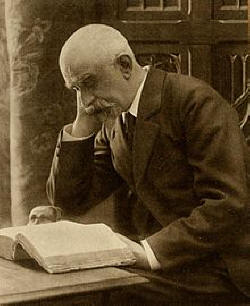
Queer Places:
Lycée Saint-Louis, 44 Boulevard Saint-Michel, 75006 Paris, Francia
Montparnasse Cemetery, 3 Boulevard Edgar Quinet, 75014 Paris, Francia
 Charles-Marie-Georges Huysmans[1] (5 February 1848 in Paris – 12 May 1907 in Paris) was a French novelist who published his works as Joris-Karl Huysmans, variably abbreviated as J. K. or J.-K.). He is most famous for the novel ''À rebours'' (1884, published in English as ''Against the Grain'' or ''Against Nature''). He supported himself by a 30-year career in the French civil service.
Charles-Marie-Georges Huysmans[1] (5 February 1848 in Paris – 12 May 1907 in Paris) was a French novelist who published his works as Joris-Karl Huysmans, variably abbreviated as J. K. or J.-K.). He is most famous for the novel ''À rebours'' (1884, published in English as ''Against the Grain'' or ''Against Nature''). He supported himself by a 30-year career in the French civil service.
Huysmans' work is considered remarkable for its idiosyncratic use of the French language, large vocabulary, descriptions, satirical wit and far-ranging erudition. First considered part of Naturalism, he became associated with the decadent movement with his publication of ''À rebours.'' His work expressed his deep pessimism, which had led him to the philosophy of Arthur Schopenhauer.[2] In later years, his novels reflected his study of Catholicism, religious conversion, and becoming an oblate. He discussed the iconography of Christian architecture at length in ''La cathédrale'' (1898), set at Chartres and with its cathedral as the focus of the book.
''Là-bas'' (1891), ''En route'' (1895) and ''La cathédrale'' (1898) are a trilogy that feature Durtal, an autobiographical character whose spiritual progress is tracked and who converts to Catholicism. In the novel that follows, ''L'Oblat'' (1903), Durtal becomes an oblate in a monastery, as Huysmans himself was in the Benedictine Abbey at Ligugé, near Poitiers, in 1901.[3] [4] ''La cathédrale'' was his most commercially successful work. Its profits enabled Huysmans to retire from his civil service job and live on his royalties.
Huysmans was born in Paris in 1848. His father Godfried Huysmans was Dutch, and a lithographer by trade. His mother Malvina Badin Huysmans had been a schoolmistress. Huysmans' father died when he was eight years old. After his mother quickly remarried, Huysmans resented his stepfather, Jules Og, a Protestant who was part-owner of a Parisian book-bindery.
During childhood, Huysmans turned away from the Roman Catholic Church. He was unhappy at school but completed his coursework and earned a baccalauréat.
For 32 years, Huysmans worked as a civil servant for the French Ministry of the Interior, a job he found tedious. The young Huysmans was called up to fight in the Franco-Prussian War, but was invalided out with dysentery. He used this experience in an early story, "''Sac au dos''" (Backpack) (later included in his collection, ''Les Soirées de Médan'').
After his retirement from the Ministry in 1898, made possible by the commercial success of his novel, ''La cathédrale'', Huysmans planned to leave Paris and move to Ligugé. He intended to set up a community of Catholic artists, including Charles-Marie Dulac (1862-1898). He had praised the young painter in ''La cathédrale''. Dulac died a few months before Huysmans completed his arrangements for the move to Ligugé, and he decided to stay in Paris.
In addition to his novels, Huysmans was known for his art criticism in ''L'Art moderne'' (1883) and ''Certains'' (1889). He was a founding member of the Académie Goncourt. An early advocate of Impressionism, he admired such artists as Gustave Moreau and Odilon Redon.
In 1905 Huysmans was diagnosed with cancer of the mouth. He died in 1907 and was interred in the Cimetière de Montparnasse, Paris.
Huysmans never married or had children. He had a long-term, on-and-off relationship with Anna Meunier, a seamstress.[5]
He used the name Joris-Karl Huysmans when he published his writing, as a way of honoring his father's ancestry. His first major publication was a collection of prose poems, ''Le drageoir aux épices'' (1874), which were strongly influenced by Baudelaire. They attracted little attention but revealed flashes of the author's distinctive style.
Huysmans followed it with the novel, ''Marthe, Histoire d'une fille'' (1876). The story of a young prostitute, it was closer to Naturalism and brought him to the attention of Émile Zola. His next works were similar: sombre, realistic and filled with detailed evocations of Paris, a city Huysmans knew intimately. ''Les Soeurs Vatard'' (1879), dedicated to Zola, deals with the lives of women in a bookbindery. ''En ménage'' (1881) is an account of a writer's failed marriage. The climax of his early work is the novella ''À vau-l'eau'' (1882) (''Downstream or With the Flow''), the story of a downtrodden clerk, Monsieur Folantin, and his quest for a decent meal.
Huysmans' novel ''À rebours'' (''Against the Grain'' or ''Against Nature'' or ''Wrong Way''; 1884) became his most famous, or notorious. It featured the character of an aesthete, des Esseintes, and decisively broke from Naturalism. It was seen as an example of "decadent" literature. The description of des Esseintes' "alluring liaison" with a "cherry-lipped youth" was believed to have influenced other writers of the decadent movement, including Oscar Wilde.
It is now considered an important step in the formation of "gay literature".[6] ''À rebours'' gained notoriety as an exhibit in the trials of Oscar Wilde in 1895. The prosecutor referred to it as a "sodomitical" book. The book appalled Zola, who felt it had dealt a "terrible blow" to Naturalism.
Huysmans began to drift away from the Naturalists and found new friends among the Symbolist and Catholic writers whose work he had praised in ''À rebours.'' They included Jules Barbey d'Aurevilly, Villiers de L'Isle Adam and Léon Bloy. Stéphane Mallarmé was so pleased with the publicity his verse had received from the novel that he dedicated one of his most famous poems, "Prose pour des Esseintes", to its hero. Barbey d'Aurevilly told Huysmans that after writing ''À rebours,'' he would have to choose between "the muzzle of a pistol and the foot of the Cross." Huysmans, who had received a secular education and abandoned his Catholic religion in childhood, returned to the Catholic Church eight years later.[7]
Huysmans' next novel, ''En rade'', an unromantic account of a summer spent in the country, did not sell as well as its predecessor.
His ''Là-bas'' (1891) attracted considerable attention for its portrayal of Satanism in France in the late 1880s.[8] [9] He introduced the character Durtal, a thinly disguised self-portrait. The later Durtal novels, ''En route'' (1895), ''La cathédrale'' (1898) and ''L'oblat'' (1903), explore Durtal/Huysmans' conversion to Roman Catholicism.[10] ''En route'' depicts Durtal's spiritual struggle during his stay at a Trappist monastery. In ''La cathédrale'' (1898), the protagonist is at Chartres, intensely studying the cathedral and its symbolism. The commercial success of this book enabled Huysmans to retire from the civil service and live on his royalties. In ''L'Oblat'', Durtal becomes a Benedictine oblate. He finally learns to accept the world's suffering.
Huysmans' work was known for his idiosyncratic use of the French language, extensive vocabulary, detailed and sensuous descriptions, and biting, satirical wit. It also displays an encyclopaedic erudition, ranging from the catalogue of decadent Latin authors in ''À rebours'' to the discussion of the iconography of Christian architecture in ''La cathédrale''. Huysmans expresses a disgust with modern life and a deep pessimism. This had led him first to the philosophy of Arthur Schopenhauer. Later he returned to the Catholic Church, as noted in his Durtal novels.
Huysmans was made a ''Chevalier de la Légion d'honneur'' in 1892, for his work with the civil service. In 1905, his admirers persuaded the French government to promote him to ''Officier de la Légion d'honneur'' for his literary achievements.
My published books:


BACK TO HOME PAGE

- ^ Joris-Karl Huysmans, From Wikipedia, the free encyclopedia
- ^ Twenty–three year–old Schopenhauer, who had a great influence on Huysmans, told Wieland, "Life is an unpleasant business. I have resolved to spend it reflecting on it. (''Das Leben ist eine mißliche Sache. Ich habe mir vorgesetzt, es damit hinzubringen, über dasselbe nachzudenken.'')" (Rüdiger Safranski, ''Schopenhauer and the Wild Years of Philosophy'', Chapter 7).
- ^ Keeler, Sister Jerome (1950). "J.–K. Huysmans, Benedictine Oblate," ''American Benedictine Review,'' Vol. I, pp. 60–66.
- ^ The Cathedral, Introduction, Dedalus 1997
- ^ cite web|last1=Gollner|first1=Adam|title=What Houellebecq Learned from Huysmans|url=http://www.newyorker.com/books/page-turner/what-houellebecq-learned-from-huysmans|website=The New Yorker|accessdate=18 November 2015
- ^ cite web |url=http://www.glbtq.com/literature/huysmans_jk.html |title=Huysmans, Joris-Karl (1848–1907) |year=2002 |last=McClanahan |first=Clarence |accessdate=2007-08-11
- ^ Baldick, Robert (1959). Introduction to ''Against Nature'', his translation of Huysmans' ''Á rebours''. Harmondsworth: Penguin, p. 12.
- ^ Rudwin, Maxmilian J. (1920). [http://babel.hathitrust.org/cgi/pt?id=njp.32101064304957;view=1up;seq=262 "The Satanism of Huysmans,"] ''The Open Court,'' Vol. XXXIV, pp. 240–251.
- ^ Thurstan, Frederic (1928). "Huysmans' Excursion into Occultism," ''Occult Review'', Vol. XLVIII, pp. 227–236.
- ^ Hanighan, F.C. (1931). "Huysmans Conversion," ''The Open Court,'' Vol. XLV, pp. 474–481.


 Charles-Marie-Georges Huysmans[1] (5 February 1848 in Paris – 12 May 1907 in Paris) was a French novelist who published his works as Joris-Karl Huysmans, variably abbreviated as J. K. or J.-K.). He is most famous for the novel ''À rebours'' (1884, published in English as ''Against the Grain'' or ''Against Nature''). He supported himself by a 30-year career in the French civil service.
Charles-Marie-Georges Huysmans[1] (5 February 1848 in Paris – 12 May 1907 in Paris) was a French novelist who published his works as Joris-Karl Huysmans, variably abbreviated as J. K. or J.-K.). He is most famous for the novel ''À rebours'' (1884, published in English as ''Against the Grain'' or ''Against Nature''). He supported himself by a 30-year career in the French civil service.